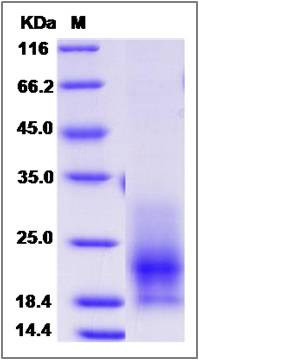Cynomolgus CD63 / Tspan-30 / Tetraspanin-30 Protein (His Tag)
CD63
- 100ug (NPP4417) Please inquiry
| Catalog Number | P90191-C08H |
|---|---|
| Organism Species | Cynomolgus |
| Host | Human Cells |
| Synonyms | CD63 |
| Molecular Weight | The recombinant cynomolgus CD63 comprises 112 amino acids and has a calculated molecular mass of 13 KDa. The apparent molecular mass of it is approximately 22 and 19 KDa in SDS-PAGE under reducing conditions. |
| predicted N | Ala 103 |
| SDS-PAGE |  |
| Purity | (71.5+25.3) % as determined by SDS-PAGE |
| Protein Construction | A DNA sequence encoding the cynomolgus CD63 (NP_001771.1) (Ala103-Val203) was expressed with a polyhistidine tag at the C-terminus. |
| Bio-activity | |
| Research Area | Cancer |Oncoprotein & suppressor & biomarker |Tumor biomarker |Tumor antigen |
| Formulation | Lyophilized from sterile PBS, pH 7.4. 1. Normally 5 % - 8 % trehalose and mannitol are added as protectants before lyophilization. Specific concentrations are included in the hardcopy of COA. |
| Background | The cluster of differentiation (CD) system is commonly used as cell markers in immunophynotyping. Different kinds of cells in the immune system can be identified through the surface CD molecules which associating with the immune function of the cell. There are more than 320 CD unique clusters and subclusters have been identified. Some of the CD molecules serve as receptors or ligands important to the cell through initiating a signal cascade which then alter the behavior of the cell. Some CD proteins do not take part in cell signal process but have other functions such as cell adhesion. Cluster of differentiation 63 (CD63) is a member of the CD family and the transmembrane 4 superfamily,also known as the tetraspanin family. CD63 is a cellular surface glycoprotein characterized by the presence of four bydrophobic domains. CD63 had functions in mediating signal transduction processes and then regulate variety of cellular processes such as cell proliferation, activation and motility. It has reported that CD63 protein associated with tumor progression and served as a blood platlet activation marker and the deficiency of this protein may be associated with Hermansky-Pudlak syndrome. |
| Reference |
